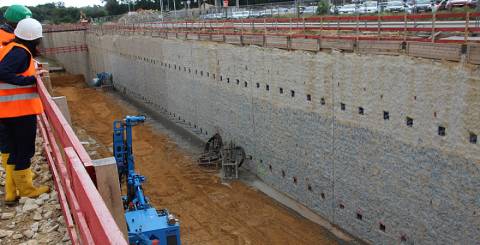How Diaphragm Walls Differentiate From Piling Work Service

Diaphragm Walls: How Do They Work?
A diaphragm wall is a type of retaining wall that is constructed using reinforced concrete panels. The purpose of a diaphragm wall is to support the soil around an excavation, preventing it from collapsing into the excavation site. Diaphragm walls are typically used in the construction of deep excavations, such as for underground parking garages or the foundations of tall buildings.
A diaphragm wall is a strengthened concrete shape that is constructed into the floor to form a non-stop vertical barrier. It is typically used to retain soil or other materials in a cut or excavation or to provide support for an adjacent structure.
To construct a diaphragm wall, a trench is first excavated in the ground using specialized equipment. The trench is then filled with reinforced concrete, which is poured into layers and compacted using a vibrating tool. Steel reinforcement bars, or rebar, are also added to the concrete to provide additional strength and support.
Once the concrete has cured, the wall is left to stand on its own, providing a strong, vertical barrier that can retain soil or support other structures. In some cases, the diaphragm wall may also be fitted with drainage pipes or other features to help manage water flow and prevent water from building up behind the wall.
Overall, diaphragm walls are an effective solution for retaining soil and providing support for adjacent structures in a wide range of construction projects.
Piling Services: How Do They Work?
Piling is a construction technique in which long, slender columns are driven into the ground to provide support for a building or other structure. Piling machine is often used in areas where the soil is not strong enough to support the weight of the structure or where the structure needs to be raised above the ground to protect it from flooding or other environmental hazards. Piling services are provided by companies that specialize in the design, installation, and inspection of pile foundations. These companies use a variety of specialized equipment, such as drilling rigs and pile-driving hammers, to install the piles. Once the piles are in place, they are typically reinforced with concrete to provide additional strength and stability.
Piling is a method used to create deep foundations for constructions and different structures. In this technique, long, slender columns of concrete or other materials are driven into the ground to support the weight of the structure above.
There are several different methods for constructing piles, depending on the specific site conditions and the type of structure being built. One common method is called driven piling, in which the piles are driven into the ground using a pile driver, a large piece of equipment that delivers repeated blows to the top of the pile to push it into the ground. Another method is called bored piling, in which a hole is drilled into the ground and the pile is placed inside it, either by hand or with the use of specialized equipment.
Once the piles are in place, they are typically connected to the structure above using a pile cap, a large concrete block that distributes the weight of the structure evenly across the piles. The pile cap may also be reinforced with steel rebar to provide additional strength and support.
Overall, piling is a versatile and effective technique for creating deep foundations for buildings and other structures, allowing them to be built on a wide range of soil conditions and terrain.
How Diaphragm Walls Differentiate From Peeling Work Service
Diaphragm walls and piling are two different techniques used in the construction industry. A diaphragm wall is a strengthened concrete structure that is constructed into the floor to shape a non-stop vertical barrier, whilst piling work service is a method used to create deep foundations for constructions and different structures.
One key difference between the two is the purpose for which they are used. Diaphragm walls are typically used to retain soil or other materials in a cut or excavation, or to provide support for an adjacent structure. Piling, on the other hand, is used to create deep foundations for buildings and other structures.
Another difference is the way in which they are constructed. Diaphragm walls are typically constructed by excavating a trench in the ground and then filling it with reinforced concrete. Piling, on the other hand, involves driving long, slender columns of concrete or other materials into the ground to support the weight of the structure above.
Overall, while both diaphragm walls and piling serve important functions in the construction industry, they are different in terms of their purpose and construction methods.
Diaphragm walls and piling machines can be used on rent. Diaphragm walls and piling machines are profitable to rent instead of buying. One of the biggest advantages of renting equipment is that it can keep you cash in the long run. In many instances, renting has become a conceivable choice for many companies and affords them the capability to reduce charges and run a more financially stable business.
Similar Articles
The presence of reserved signs from Inkohoreca on tables becomes visible as soon as you enter a restaurant. Despite being a small element the reserved signs help a restaurant operate more effectively.
In the current era, the term packaging definitely refers to more than just a technique to keep a product safe, instead, it serves as an essential factor for the quality of the product, the brand’s reputation, and overall customer experience
Learn why failing to blur video footage in your business can lead to privacy violations, legal fines, and reputational damage. Protect identities and stay compliant.
Want to know which business video ideas actually work? The numbers tell a powerful story—84% of people say they've purchased a product after watching a brand's video, and social media videos alone have helped 93% of brands attract new customers.
Running a wellness business can be incredibly rewarding, but it also comes with many challenges. From managing appointments and handling payments to marketing your services and keeping customers engaged, there’s a lot to juggle
Efficient management is the backbone of a thriving fitness studio. By leveraging fitness studio scheduling software, you can streamline your operations and enhance the member experience. This robust tool allows you to organize classes, manage appointments, and coordinate staff schedules seamlessly.
Event marketing and trade show exhibitions depend on the use of attractive, engaging, and well-placed booths that captivate and retain the attention of the viewers. Portable custom event displays remain essential because they allow effective visitor engagement and improve brand visibility, resulting in customer conversion.
Imagine this: You’re running a busy restaurant, and suddenly, your walk-in fridge fails overnight. By morning, thousands of pounds worth of food is spoiled.
In businesses and offices, completing signature tasks quickly and accurately is essential. The right tools can greatly reduce time spent on routine paperwork.









